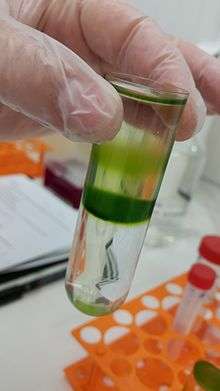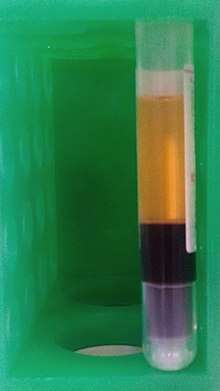Differential centrifugation
Differential centrifugation (also differential velocity centrifugation) is a common procedure in biochemistry and cell biology used to separate organelles and other sub-cellular particles on the basis of sedimentation rate. Although often applied in biological analysis, differential centrifugation is a general technique also suitable for crude purification of non-living suspended particles (e.g. nanoparticles, colloidal particles, viruses). In a typical case where differential centrifugation is used to analyze cell-biological phenomena (e.g. organelle distribution), a tissue sample is first lysed to break the cell membranes and release the organelles and cytosol. The lysate is then subjected to repeated centrifugations, where particles that sediment sufficiently quickly at a given centrifugation force for a given time form a compact "pellet" at the bottom of the centrifugation tube. After each centrifugation, the supernatant (non-pelleted solution) is removed from the tube and re-centrifuged at an increased centrifugal force and/or time. Differential centrifugation is suitable for crude separations on the basis of sedimintation rate, but more fine grained purifications may be done on the basis of density through equilibrium density-gradient centrifugation.[1]



Theory
In a viscous fluid, the rate of sedimentation of a given suspended particle (as long as the particle is more dense than the fluid) is largely a function of the particle size. Larger particles sediment more quickly and at lower centrifugal forces. If a particle is less dense than the fluid (e.g., fats in water), the particle will not sediment, but rather will float, regardless of strength of the g-force experienced by the particle. In contrast, a more specialized equilibrium density-gradient centrifugation produces a separation profile dependent on particle-density alone, and therefore is suitable for more fine-grained separations.
High g-force makes sedimentation of small particles much faster than Brownian diffusion, even for very small (nanoscale) particles. When a centrifuge is used, Stokes' law must be modified to account for the variation in g-force with distance from the center of rotation.
where
- D is the minimum diameter of the particles expected to sediment (m)
- η (or µ) is the fluid dynamic viscosity (Pa.s)
- Rf is the final radius of rotation (m)
- Ri is the initial radius of rotation (m)
- ρp is particle volumetric mass density (kg/m³)
- ρf is the fluid volumetric mass density (kg/m³)
- ω is the angular velocity (radian/s)
- t is the time required to sediment from Ri to Rf (s)
Procedure
Differential centrifugation can be used with intact particles (e.g. biological cells, microparticles, nanoparticles), or used to separate the component parts of a given particle. Using the example of a separation of eukaryotic organelles from intact cells, the cell must first be lysed and homogenized (ideally by a gentle technique, such as dounce homogenization; harsher techniques or over homogenization will lead to a lower proportion of intact organelles). Once the crude organelle extract is obtained, it may be subjected to a varying centrifugation speeds to separate the organelles:
| Sample input | G force | Time | Instrument needed | Pellet contents | Supernatant contents |
|---|---|---|---|---|---|
| Unlysed (eukaryotic) cells | 100 x g | 5 min | Benchtop fixed-angle centrifuge, or swinging bucket centrifuge | Intact (eukaryotic) cells, macroscopic debris | Varies depending on sample |
| Gently lysed cells (e.g. dounce homogenizer) | 600 x g | 10 min | Benchtop fixed-angle centrifuge, or swinging bucket centrifuge | Nuclei | Cytosol, non-nuclei organelles |
| Supernatant of previous row | 15,000 x g | 20 min | Benchtop fixed-angle centrifuge | Mitochondria, chloroplasts, lysosomes, peroxisomes | Cytosol, microsomes (known as post mitochondrial supernatant) |
| Supernatant of previous row | 50,000 x g - 100,000 x g | 60 min | High speed fixed-angle centrifuge, or vacuum ultracentrifuge | Plasma membrane, microsomal fraction, large polyribisomes | Cytosol, ribosomal subunits, small poly ribosomes, enzyme complexes |
| Supernatant of previous row | 50,000 x g - 100,000 x g | 120 min | Vacuum ultracentrifuge | Ribosomal subunits, small poly ribosomes, some soluble enzyme complexes | Cytosol |
Ultracentrifugation
The lysed sample is now ready for centrifugation in an ultracentrifuge. An ultracentrifuge consists of a refrigerated, low-pressure chamber containing a rotor which is driven by an electrical motor capable of high speed rotation. Samples are placed in tubes within or attached to the rotor. Rotational speed may reach up to 100,000 rpm for floor model, 150,000 rpm for bench-top model (Beckman Optima Max-XP or Sorvall MTX150), creating centrifugal speed forces of 800,000g to 1,000,000g. This force causes sedimentation of macromolecules, and can even cause non-uniform distributions of small molecules.
Since different fragments of a cell have different sizes and densities, each fragment will settle into a pellet with different minimum centrifugal forces. Thus, separation of the sample into different layers can be done by first centrifuging the original lysate under weak forces, removing the pellet, then exposing the subsequent supernatants to sequentially greater centrifugal fields. Each time a portion of different density is sedimented to the bottom of the container and extracted, and repeated application produces a rank of layers which includes different parts of the original sample. Additional steps can be taken to further refine each of the obtained pellets.
Sedimentation depends on mass, shape, and partial specific volume of a macromolecule, as well as solvent density, rotor size and rate of rotation. The sedimentation velocity can be monitored during the experiment to calculate molecular weight. Values of sedimentation coefficient (S) can be calculated. Large values of S (faster sedimentation rate) correspond to larger molecular weight. Dense particle sediments more rapidly. Elongated proteins have larger frictional coefficients, and sediment more slowly to ensure accuracy.
See also
| Library resources about Ultracentrifugation |
- Buoyant density ultracentrifugation
- Jerome Vinograd
References
- Darnell, James; Baltimore, David; Matsudaira, Paul; Zipursky, S. Lawrence; Berk, Arnold; Lodish, Harvey (2000). "Purification of Cells and Their Parts". Cite journal requires
|journal=(help) - Darnell, James; Baltimore, David; Matsudaira, Paul; Zipursky, S. Lawrence; Berk, Arnold; Lodish, Harvey (2000). "Purification of Cells and Their Parts". Cite journal requires
|journal=(help)
- Gerald Karp (19 October 2009). Cell and Molecular Biology: Concepts and Experiments. John Wiley & Sons. pp. 28–. ISBN 978-0-470-48337-4.
- Roger A. Davis and Jean E. Vance, Structure, assembly and secretion of lipoproteins, 1996, Elsevier Science B. V.
http://www.chemeurope.com/en/encyclopedia/Sucrose_gradient_centrifugation.html